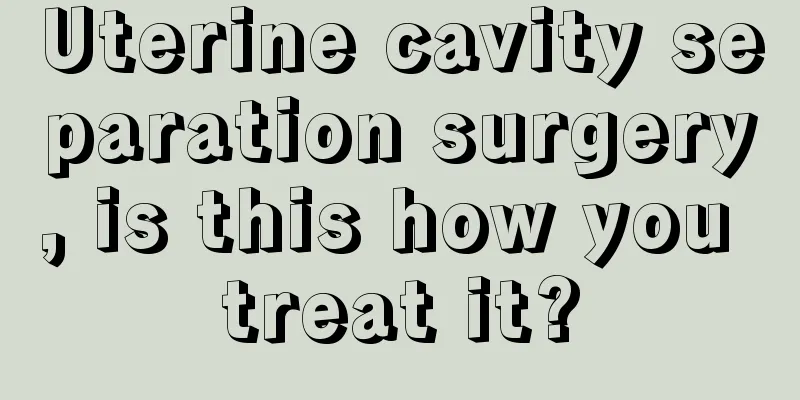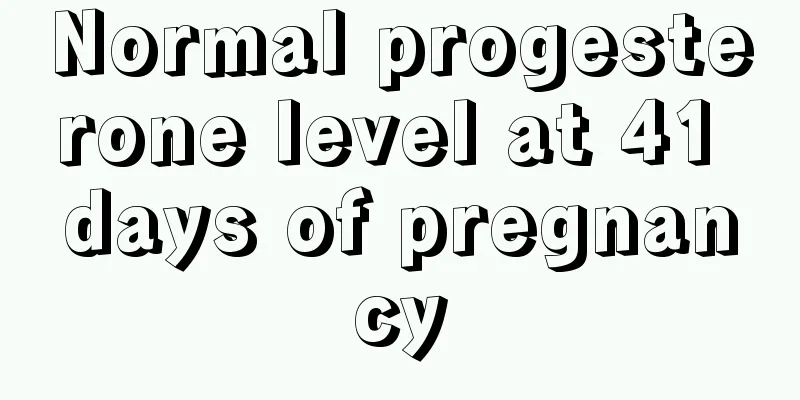Uterine cavity separation surgery, is this how you treat it?

|
Endometrial separation surgery is a common method for treating intrauterine adhesions. It is mainly suitable for the treatment of infertility after curettage or abortion in women with normal menstruation. Some patients may also have amenorrhea or cyclical pain in the lower abdomen. It can also be used to treat habitual abortion or acute infection of the endometrium. 1. How to treat uterine cavity separation How to treat uterine cavity separation? Patients with uterine cavity separation can take some drugs to contract the uterus and take anti-inflammatory drugs at the same time. The recovery of the uterus requires a certain process. During the treatment, patients should pay more attention to rest and avoid physical activities. In terms of diet, you should develop good eating habits, eat more fresh fruits and vegetables, high-protein foods, and drink plenty of water to replenish the water needed by the body. After your body recovers, you can do moderate exercise, such as walking, jogging, etc. At the same time, stay optimistic, pay attention to timely adjustment and reduce psychological pressure, and maintain a balance between work and study. 2. What to do if the uterine cavity separates Uterine cavity separation can be mild or severe. Mild cases can be treated through diet and exercise. This requires patients to eat more vegetables, fruits, and high-protein foods, and drink plenty of water to keep the body hydrated. In terms of sports, you should participate in various sports exercises, strengthen your physical fitness, and have a scientific life routine. It is also important to fully relax yourself and keep a comfortable mood. If these methods cannot achieve effective treatment, drugs can be used for auxiliary treatment, such as uterine contraction drugs and anti-inflammatory drugs, which can have a certain therapeutic effect when taken together. If the situation is more serious, surgery may be required. Therefore, in cases of uterine cavity separation, the treatment method should be chosen according to the severity of the patient's condition. 3. Uterine cavity separation surgery Intrauterine adhesion separation is mainly suitable for the treatment of infertility after curettage or abortion in women with normal menstruation in the past. Some patients may also experience amenorrhea or cyclical pain in the lower abdomen. It can also be used to treat habitual miscarriage or acute endometrial infection. Hysterosalpingography (HSG) shows deformation of the uterine cavity, single or multiple filling defects, irregular shape, and clear boundaries, which do not disappear due to increasing the amount and pressure of contrast agent. It can also be treated with intrauterine adhesion separation. However, it should not be performed on patients suspected of having endometrial cancer or other malignant tumors. |
<<: What to do if you feel upset during menopause? Broadening your horizons is the best solution
>>: What causes intrauterine bleeding?
Recommend
Ovarian removal surgery
Ovarian removal surgery is performed to treat dis...
What is female endocrine regulation like?
For women, endocrine regulation is very important...
What if the menstrual blood is black and has a strange smell?
Menstruation occurs once a month in women, so it ...
Why is the leucorrhea red after menstruation?
Women should pay attention to choosing simple foo...
What should I do if I have hot flashes and sweat during menopause? These four aspects must be done well
When people reach menopause, they are prone to fe...
Girls have a lot of lip hair
Some people are born with extra lip hair. The so-...
Can I eat enough eggplant during the confinement period?
After giving birth, women enter a critical period...
A small amount of eye drops can make a big difference when used correctly. Do you really understand the method?
Author: Zeng Ting, 920th Hospital of the Joint Lo...
Causes of blood clots during menstruation
Everyone must know the importance of menstruation...
What should women do if they have frequent, painful, or bloody urination?
Each of us may have experienced frequent and pain...
Eight exercises for women to train their abdominal muscles
Although in most people's eyes, it is a trend...
What to do if the laptop wireless network connection is not available? What to do if the laptop wireless network cannot be found?
Laptops can be said to have brought too much conv...
Is it normal to stop having menstruation after 2 days?
Low menstrual volume is also known as scanty mens...
Things to note when you are pregnant with your second child at the age of 40
After the two-child policy was opened, many famil...
What are the symptoms of menopausal syndrome?
What are the symptoms of menopausal syndrome? In ...









